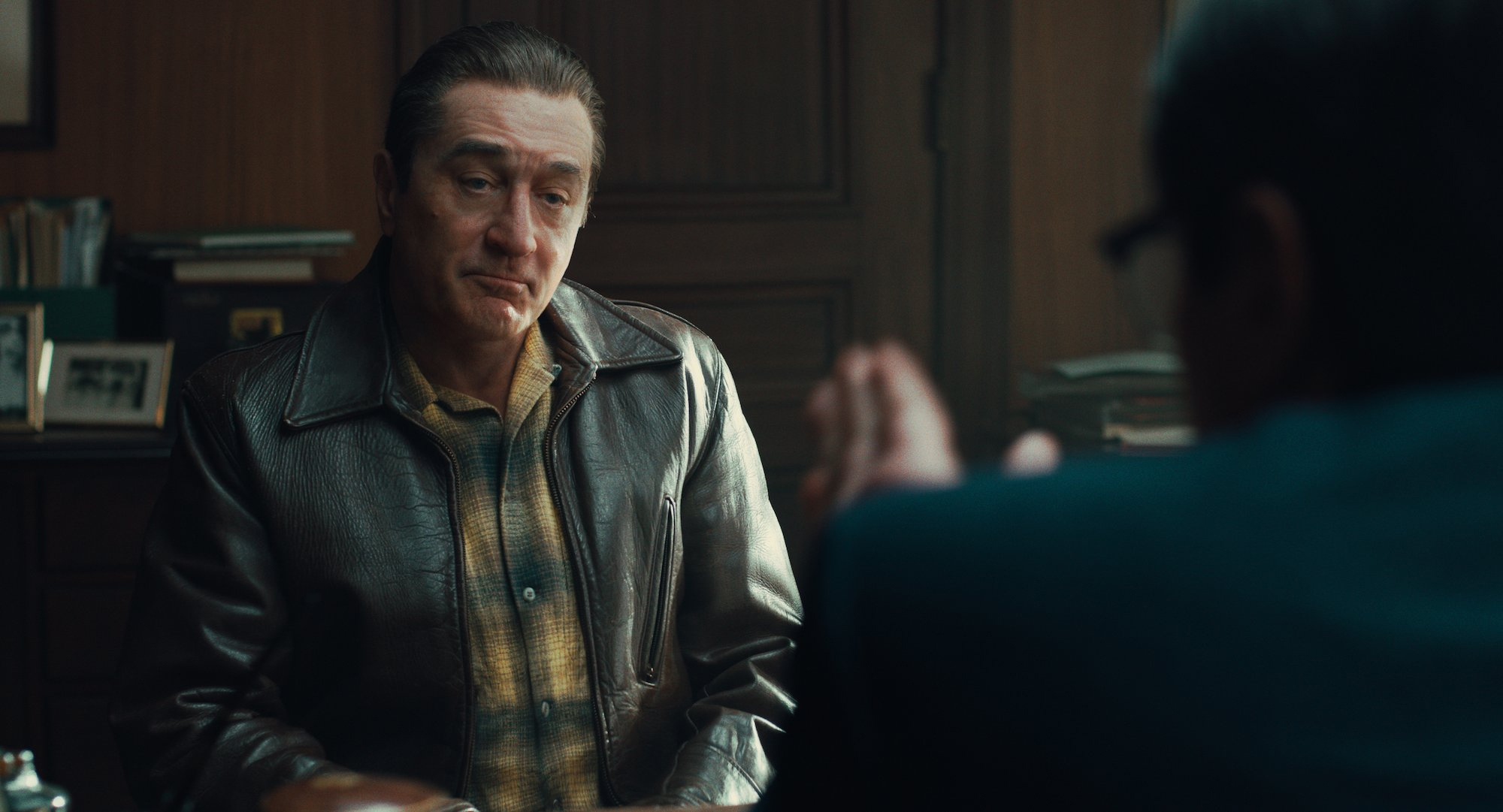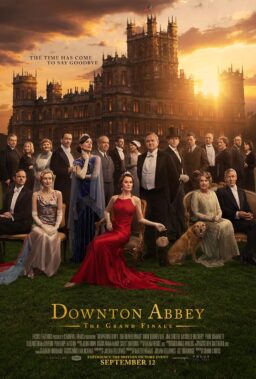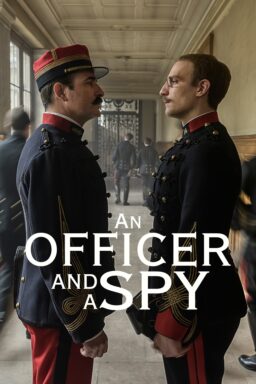Martin Scorsese’s “The Irishman” deals with the life of hitman Frank Sheeran (Robert DeNiro), from his early days as a truck driver where his blatant dishonesty moves him up the ranks of the local mob. He ends up doing occasional hits for mob boss Russell Bufalino (Joe Pesci) and in the process becomes one of Jimmy Hoffa’s (Al Pacino) most trusted lieutenants. Like many of Scorsese mob movies this one is partly told in flashback (during a rather eventful car trip) with its last chapter focusing on the assassin’s surprisingly subdued denouement.
As every other Scorsese mob movie, “The Irishman” deals in excruciating detail with the inner workings of its core subject. There are countless particulars related to Frank’s profession such as choosing the right weapon for each particular job or a step by step tutorial on how to whack a rival who gets out of line. There are also the small, unrelated wisdoms that Scorsese loves to share (think of the unforgettable method for making garlic liquefy in “Goodfellas”) and they go a long way to make his films more memorable, like the best chili dog in America or how to consume alcohol in front of someone who doesn’t allow people to drink around him. Also fascinating are the insights on how mob leaders actually give the go ahead of a murder with just the subtlest of eyebrow moves, the way rivals “send a message” at each other or the use of the most unassuming phrases that in their context become unmistakable threats (think “it is what it is,” “it’s the bottom line,” or “he won’t need it”, the latter in regard to an advance on a job that won’t require completion and won’t require a refund either).
“The Irishman” can be described as the “Forrest Gump” of mob movies. Throughout his life and career Frank somehow found himself in the middle of the most renowned moments in US mob history. From their involvement in getting Hoffa’s teamster pensions to finance the building of Las Vegas, to allegedly getting President Kennedy elected with the help of some deceased volunteers, to trying to overturn Cuba’s Castro, and later by assassinating the same “ungrateful” president they got elected in the first place (as suggested when Russ states that “if they can whack a president, they can whack the president of an union”). “The Irishman” deals with several subjects that other films have already dedicated their entirety to portray, including “Casino” (1995), “Hoffa” (1992), “JFK” (1991), and even a bit of “All the President’s Men” (1976), and it conveys some of their themes with as much insight as any of the others.
When it comes to Scorsese’s filmography, at first sight “The Irishman” resembles “Goodfellas” and “Casino.” To be fair, most of Scorsese’s mob features share a similar style and the use of the same color palettes with similar ultra-green lawns and lots of browns and burgundies. They all include countless moments of tension between the characters where the threat of violence is imminent. Their mob bosses don’t live in fortresses like the Sopranos or in compounds like the Corleones and they hang around in simple outdoor malls and stay at modest Howard Johnson’s hotels. In other words, Scorsese clearly avoids glamorizing their lives. “The Irishman” has a very similar feel to “Goodfellas” in particular to the point where it is almost as if both entries belong to the same “universe.” When we see Joe Pesci’s Russ Bufalino attending the Copacabana club, it’s hard not to imagine him running into Joe Pesci’s Tommy DeVito from the latter movie. Even the most notable murder sequences in both features (Tommy DeVito and Hoffa’s) are eerily similar.
Of even more relevance, Scorsese’s movies all seem share the same sense of humor. A lot of the laughs in “The Irishman” come from their protagonist’s shamelessness like Ray Romano’s defending the indefensible with a conviction that rivals any of Leonardo DiCaprio’s shenanigans in “The Wolf of Wall Street” (2012). They are also laden with moments where you find yourself laughing at things you are not even sure you are supposed to. The prime example can be found in “Goodfellas” where the state of Frankie Carbone’s body at death is described as “…it took them two days to thaw him for the autopsy.” “The Irishman” is certainly no exception as when union leader Tony Pro (Stephen Graham) pulverizes a competitor in a three shredder (a la “Fargo”) simply because he had the nerve to get too many votes. Even though Scorsese never hides or mitigates any of his protagonists’ despicable actions, he tends to give them these lovable quirks and odd circumstances that somehow help them become endearing like DeNiro’s “Man of the Year” dinner with its outmoded 1970s dancers, cheesy songs and corny jokes or Pacino’s love for hot fudge sundaes and his tendency to swear out loud in front of his kids, to his loving wife’s dismay. It really helps all these movies that the director seems to find the hidden humor in just about everything.
And yet, what really makes “The Irishman” one of Scorsese’s best films is how well he handles his usual themes of weakness, betrayal, and the incredible way he portrays the eventual frailty of the once mighty. Despite all the scheming and the violence, down deep “The Irishman” is really about enduring life’s regrets as it slowly slips away with no hope for redemption. Not since the pathetically grotesque Jake LaMotta tried to find forgiveness from the brother he brutally alienated in “Raging Bull” has Scorsese come up with such an affecting conclusion to one of his movies. True, it wasn’t easy to see Henry Hill let down the friends whose families he shared vacations and birthday parties in the phenomenal “Goodfellas” but at the end of that movie it had all become a matter of who betrayed whom first. Decades later, Scorsese came up with the very powerful “Silence” (2016), but the one aspect that really spoiled that entry for me was how very little and how very late it felt to see the Andrew Garfield priest hanging to a Christian symbol at death, having previously abandoned Christ in every way imaginable.
Much has been said about how “The Irishman” shares some of the same weaknesses of Scorsese’s prior films like the irrelevance of his female characters. Then there’s Scorsese’s insistence with using similar moments in most of his movies such when a small child stares silently as the adults in the room commit some kind of atrocity. But the only two complaints I have with “The Irishman” is how flat the joke about the guy with the “big ears” felt every time it came up and, for a director with the best track record in finding younger versions of his grown actors (think of the young Henry Hill in “Goodfellas” and the child version of Matt Damon in “The Departed”) it’s hard to believe Scorsese couldn’t find an actor that resembled Bobby Kennedy at least a little more. At any rate, these are minor flaws in what’s clearly a great movie.
Much has been said about the pros and cons of the de-aging technology Scorsese used for this entry and truth be told. The “younger” characters here do move a bit slow and they tend to slouch too much for their age, but at the end of the day these faults are mostly irrelevant. The fact of the matter is that digital technology was the one miracle that allowed for the reunion of the Dream Team of mob movie casts in a worthy project with the genre’s top director, all of them well into their seventies.












